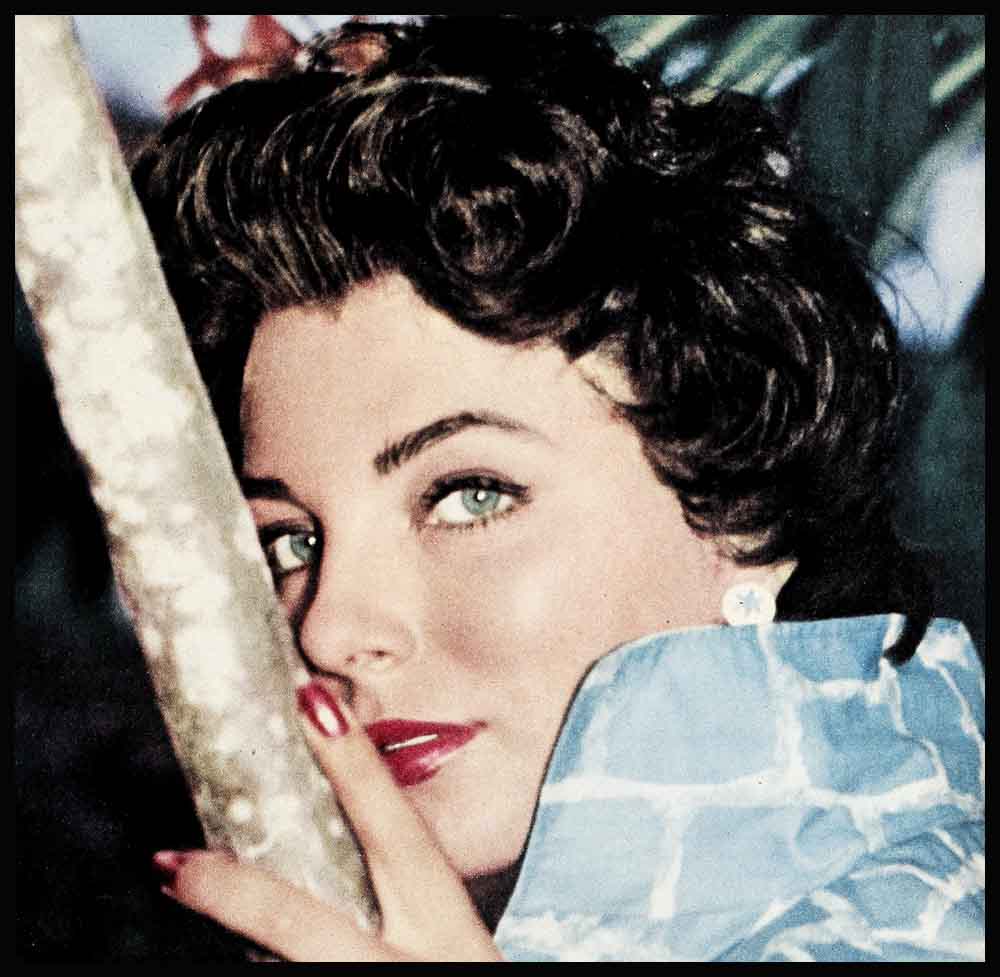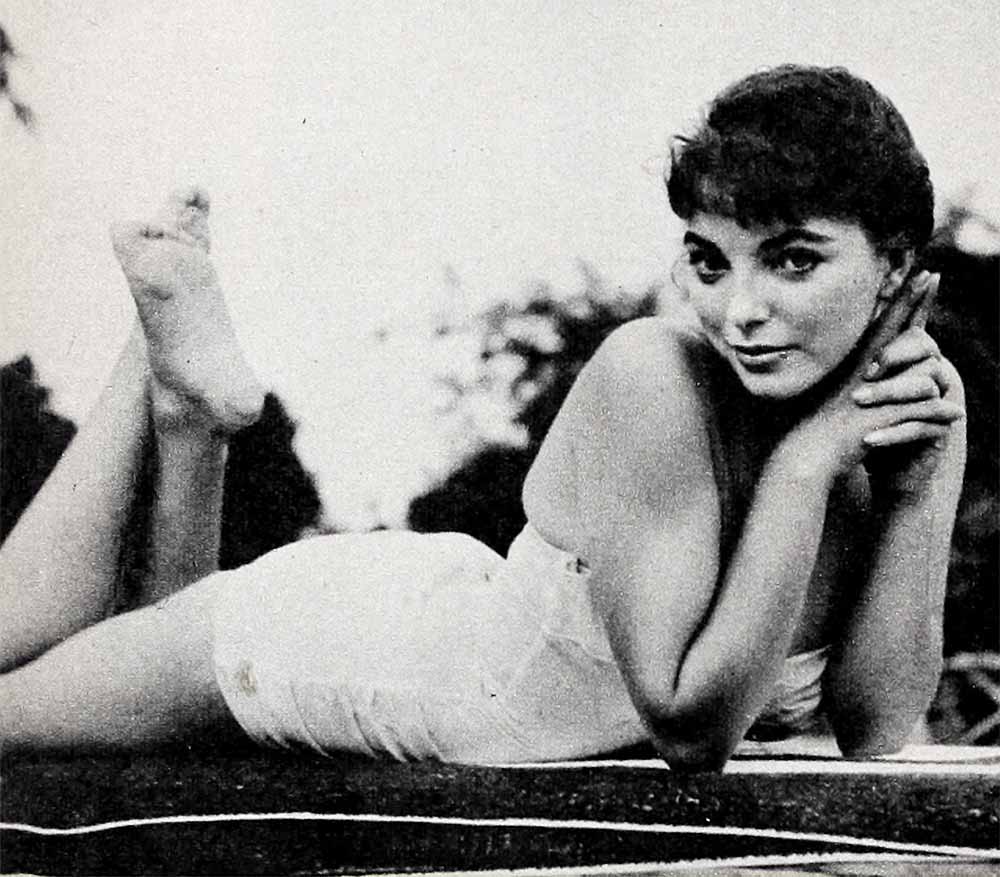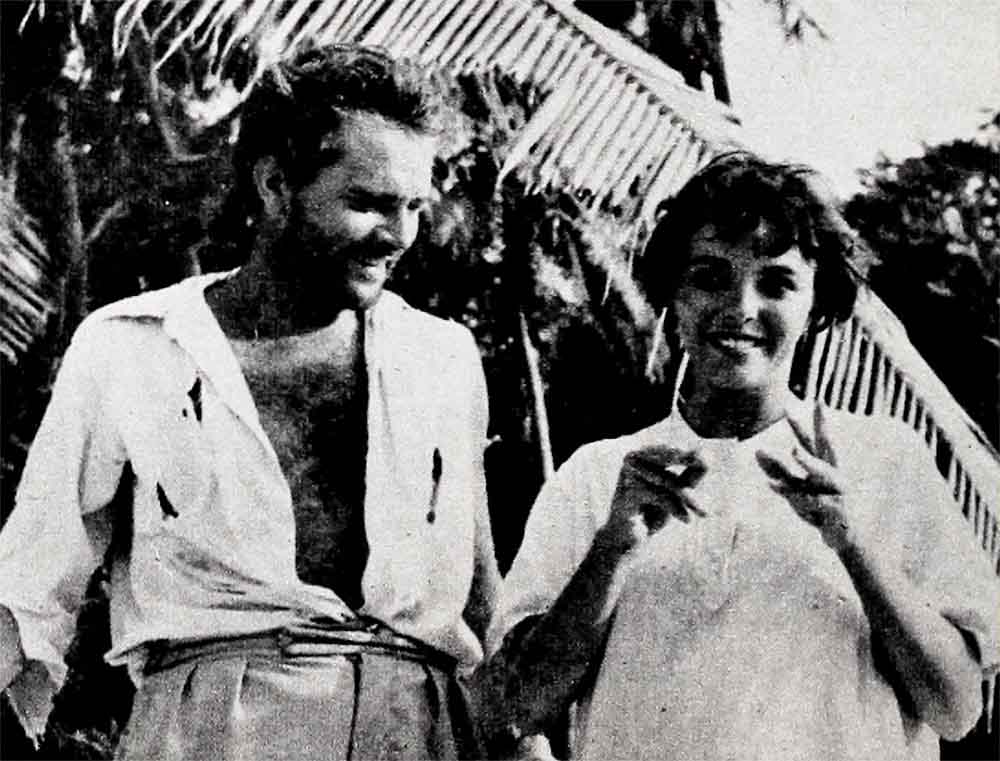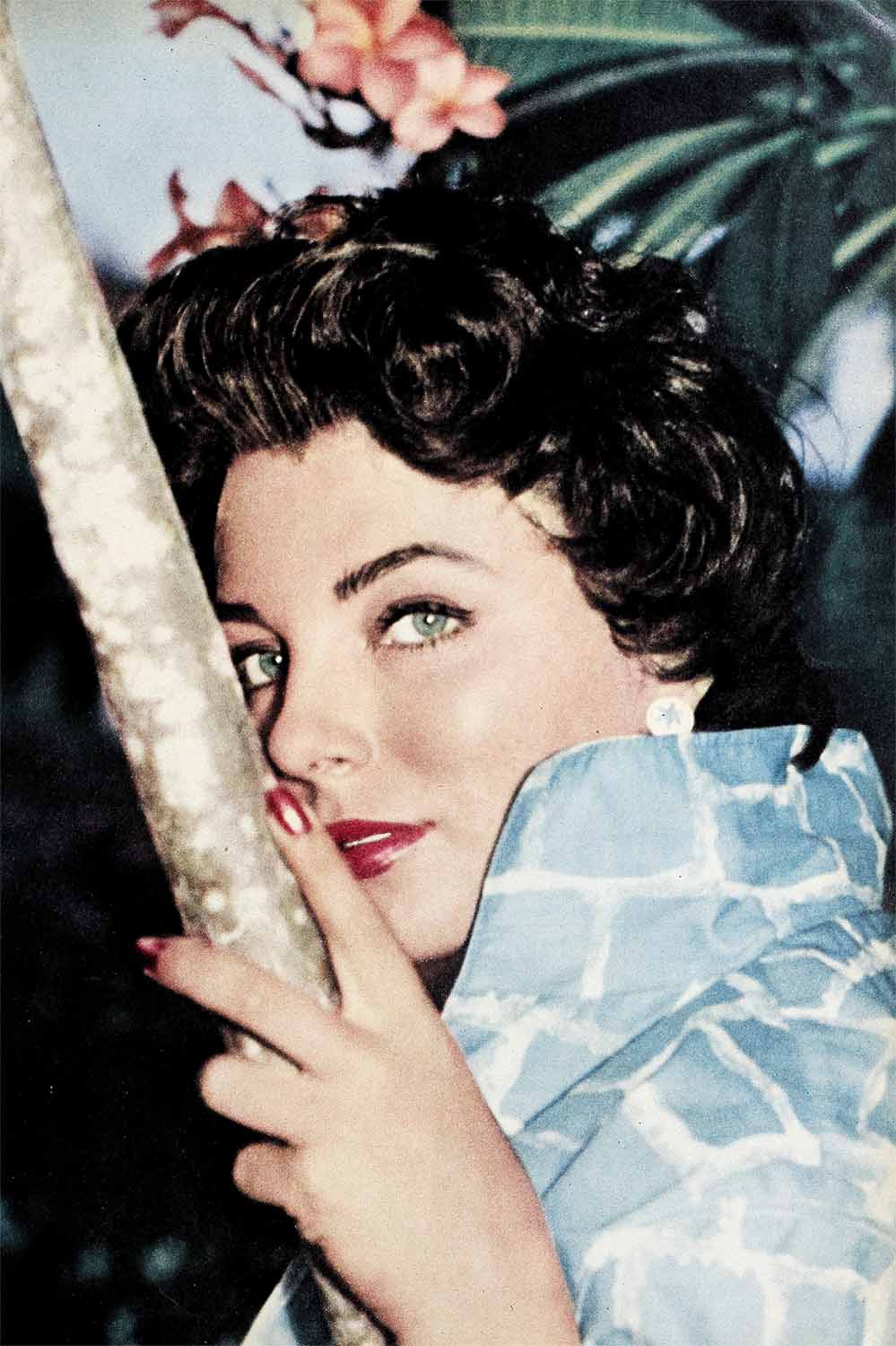
She Learned To Say No!
Joan Collins, confiding to a friend, said recently, “I used to do everything anybody told me was wrong.” And Joan, who is one of the frankest girls in Hollywood, added, “And I knew I was wrong, too.”
This confession of past sins is a key to the Collins character that has alternately bewildered and charmed, shocked and delighted the people who knew and worked with her in the past. Her independent spirit, her unwillingness to conform, led to a series of misadventures that Joan now looks back on with amusement mixed with a little sorrow. When she was twelve she was dismissed from a very fashionable boarding school in England for an infraction of the rules, at eighteen she entered into an unhappy marriage with a man twelve years her senior (“Max Reed was the first grown-up I ever met and I wanted to be grown-up too”) and three years ago she arrived in Hollywood looking and acting like a juvenile delinquent—a part she had played in eight grade-B British shockers. A columnist reported at the time, “She bounced into town wearing makeup an inch thick and daggered platinum fingernails, then confused her American hosts by mixing bop talk with a clipped British accent.” Her description of Hollywood as “cool and crazy” made good copy for the papers and she made a point of seeing to it that the description fitted her.
AUDIO BOOK
Joan was hailed as a real bundle from Blighty, Britain’s answer to Ava Gardner, a sexy siren and a ball of fire. Nobody inquired whether or not she could act. It was enough that she was billed as “Britain’s New Bad Girl,” and that the staid New York Times called her “a torrid baggage.” Certainly the movies she had appeared in were no clues to her talents. Besides her British efforts, she had made “Land of the Pharaohs,” a Howard Hawks picture filmed in Italy which hadn’t hurt her reputation as a sexy siren. She paraded about in it wearing skimpy Cleopatra type costumes.
But while the publicity mills were grinding out stories about her alleged wickedness, with appropriate pictures to prove the point, Joan was thinking about her career. For behind the facade of the alluring figure and the lovely face was an actress. Being a real professional, she had taken any parts that had come her way and she had accepted the publicity that had gone with the “bad girl” roles. But there was simply too much talent there to be stuffed into a pair of tight blue jeans or a skimpy bathing suit forever.
Joan says, recalling this period of her life, “I realized I was killing myself as an actress.” And she adds simply, “You can’t be bad all the time and get very good.”
“Getting good” is just what Joan has been making a habit of since she decided to hang up her shingle in Hollywood. She was bounced right into a starring role in “The Girl in the Red Velvet Swing,” and while she wasn’t exactly a lady she looked and acted like one. And in contrast to the blue jeans and bandanas that had been her trademark for so long, Darryl Zanuck put her in more fancy clothes than anybody since Linda Darnell in “Forever Amber.” Joan, who has often said that she has never really liked herself in any of her pictures, had to admit in this one that she was certainly a delight to look at.

Well, if she doesn’t like herself in movies it’s certainly not that she hasn’t had the chance to identify herself with a wide range of characters. In her past four films she has played a nun (“The Seawife”), a sexy vamp (“The Opposite Sex”),a well-bred English girl (“Island in the Sun”), and a broken-down alcoholic (“The Wayward Bus”). Given a choice she reluctantly admits that it was the English girl that she enjoyed playing the most. “I suppose,” she says, “this is a rather unimaginative choice, but the girl has a great deal of character and what’s more important for me—I have something to do. It is hard work, but fun, projecting a type that isn’t really yourself at all. That’s what I want to do consistently.” And, she adds rather pointedly, “This bags under the eyes and no makeup bit has to go.”
While Joan has been establishing herself as a star (though she hasn’t quite crawled out from under the “no makeup bit”) there is a question whether or not she has found herself as a person.
A clue to this is her consuming restlessness. To use one of her own phrases, life for Joan is just a matter of “go, go, go.” It motivates everything she does. Her brisk, colorful speech, for instance. There is a jazzy flippancy to it that is startling when contrasted to her clipped British accent. And then there is her passion for traveling, her inability to settle down anywhere. She is like a perky poodle constantly tugging on a leash.
And Joan is the first to admit this. “I’m terribly restless,” she said recently. “I guess it’s because I hate and detest routine. I don’t want to know what’s going to happen to me next week, or next year, or even tomorrow. I only want to look back and recall all the things I’ve done. I’ve never planned anything in my life and look at all that’s happened to me.”
Joan’s passion for movement—whether it’s on a dance floor or in an airplane up in the sky—has reduced living to very simple terms. Her home in Hollywood is a small one-room apartment, a place to sleep, change clothes and to indulge in her favorite indoor sport—listening to music.

But even the casual life of Hollywood begins to pall for Joan after awhile and she has an urge to get up and go—somewhere, anywhere. In the past fifteen months she has traveled over sixty thousand miles and she says “that’s not nearly enough.” If she could set an itinerary for herself she’d spend spring in London, Paris or Rome, early summer in the South of France, late summer in the West Indies, autumn in New York and the winter in California. And if anybody suggested a trip while she was at one of those places she’d have her bags packed before you could say “reservation.”
Even keeping up with Joan for a day in Hollywood is exhausting. If you didn’t like music you’d really be on her “square” list. Joan’s day begins and ends with music. Before she gets out of bed she flips on her record player and it stays on as long as she is in the house. She has a huge collection of records—calypso, Afro-Cuban, show tunes, and she says, “Believe it or not, one or two classics.”
As soon as she is out of the apartment and seated in her pink Thunderbird, she’s twisting the radio dial. When she smashed her car recently, she wasn’t half as broken up about not having a car as not having a radio to listen to on her way to work.
When Joan isn’t on the set, she’s whirling off to a party or a barbecue, or the beach or movies or a dance, “anything and everything,” she says, “as long as it has variety. I’m a Gemini and I am supposed to have many moods—and I do. I’m never bored as long as I am doing something.”
But in spite of the fact that Joan is one of the “dating-est” girls in Hollywood she still feels that her social freedom is restricted because she is a woman. “Before I decided I liked being a girl, I wanted very much to be a boy,” Joan admitted frankly recently and this may also be a clue to her restlessness and independence. “I resented the freedom men have and I still do. They can go anywhere they want and do as they please. A man can phone a girl as often as he wants. If he’s turned down a dozen times, he still has the right to call again. A girl can’t call a man. If she does he will immediately label her as cheap. So girls are forced to take subtle measures to get the right man to ask her for a date.” And Joan concludes, somewhat defiantly, “I hate playing games and that’s what it comes down to!”
Joan’s argument, as far as she personally is concerned, is rather theoretical. Joan is not one to stay home. It was reported recently that Joan dated ten different men ten nights running, but this is more in the realm of publicity than the actual facts warrant. still it’s no exaggeration to say that Joan could have if she had wanted to. Actually she doesn’t play the field, and her name’s been linked with only three men since she came to Hollywood. When she first went to California there were hints at romance with Sydney Chaplin, whom she had known in England. And if one Chaplin wasn’t enough there was Charles, Jr., who occasionally “stood in” for his brother, but most frequently it was Arthur Loew, Jr.

But none of these romances became more than just grist for the gossip columns, for Joan says seriously, “I am simply not ready for a new marriage. I haven’t gotten over the first one yet. When I married Maxwell Reed I was much too young to know what I was doing or to assume any of the responsibilities of married life. I learned my lesson the hard way.” And she adds forthrightly, “I am going to be very discriminating this time before I say yes to someone I plan to spend the next fifty years with.”
And like everything else Joan is very definite about the kind of man that will be. “He must have a very large sense of humor and a total lack of conceit. He must be kind and gentle and never, never, take himself too seriously. I can’t stand pompous self-righteous ‘toadies.’ I want a man who can laugh at himself, as I do.”
One condition Joan doesn’t make is that he be any particular type. Robert Rossen, the director of “Island in the Sun,” said that when they were on location in the West Indies, Joan much preferred the company of the crew to the actors.
Recently, Sheree North, a girl as candid as Joan, had a chance to watch her friend come through one of Hollywood’s toughest tests unscathed. “There is one place on the studio lot,” Sheree said, “where all women are without artifice and equal. That’s in the harsh daylight glare of the makeup department. You can’t play the big star there—not when you haven’t your face on. So if I tell you that Joan ran this obstacle course without a misstep, you’ll understand what kind of a girl she is. I know, I liked her on sight. She had a spirit and independence and a quiet air of ‘If you like me fine, but if you don’t I won’t cry about it.’ She wasn’t going to be bothered trying to meet and ingratiate herself with the top VIP’s as so many newcomers do. She was a free soul.”
Joan, of course, is very much of an individual and glad that she is. “I think it’s good to be strong willed in a career. I’ve worked fifteen months without a break, but I am not an established star and I could be just as easily laid off for the next fifteen months. But to avoid this I have to fight for what I believe is right, for roles that I want, for a chance to be not just an actress but a good one. I’ve found being an individual helps.”
Joan has learned since she arrived in Hollywood that you can be independent and honest without being “off-beat.” At one point early in her career she confided to a friend that she had always been criticized, “by my family, at school by girls and teachers, by my agent and by the viewers in England when I got into pictures. So I reacted the only way I knew how—to be defiant to prove my point.”
Joan today is no longer defiant, she doesn’t have to shock people to gain attention nor does she have to say “no” when she wants to say “yes.” And in her discovery that she likes being a girl, she has shed the I-don’t-care manner and dress that caused her critics to refer to her as a sloppy Bohemian.
Joan said recently of herself, “Even when I am wearing blue jeans and ‘jiveing’ all night I now feel feminine.”
But from this you shouldn’t infer that Joan Collins has become a “saint” or has bowed to convention or has lost any of her zaniness and zip. She is just finding it more fun to do things for the right reasons than for the wrong ones. And she has learned that while it is often hard to say “No”—that little word can sometimes spell out the difference between heartache and happiness.
BE SURE TO SEE: Joan Collins in 20th’s “Island in the Sun” and “The Seawife.”
It is a quote. PHOTOPLAY MAGAZINE MAY 1957
AUDIO BOOK




